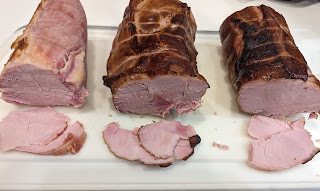First brew of 2023 and I’m getting an early start because I want to be done in time to watch the Utes in the Rose Bowl. Today I’m brewing a style I’ve never brewed before. This recipe is based on Tmavé Pivo from Pivovar Hostomice in the Czech Republic, and it’s a Czech Dark Lager. This style is much less common than the more iconic pale Czech Pale Lagers, but I'd argue they're every bit as drinkable. Locally, Offset Bier in Park City, Utah won a silver medal at the North American Brewers Association competition (part of the Mountain Brewers Beer Fest) with their version of the style, also named Tmavé Pivo.
Here’s the BJCP description of the style:
A rich, dark, malty Czech lager with a roast character that can vary from almost absent to quite prominent. Malty with an interesting and complex flavor profile, with variable levels of hopping providing a range of possible interpretations.
This style is a combination of the Czech styles tmavý ležák (11–12.9 °P) and tmavé speciální pivo (13–14.9 °P). More modern examples are drier and have higher bitterness while traditional versions often have IBUs in the 18–20 range with a sweeter balance.
Here's the recipe as I'm brewing it today:
Target OG: 1.056
Target FG: 1.012
IBUs: 41
ABV: 5.8%
3.6625# Czech floor-malted pilsner
3.6625# Munich I
1.675# Weyermann Caramunich III
1g BrewTan B in mash
2.2oz Weyermann Carafa III (added at sparge)
8.6g Magnum (60 min)
10.5g Magnum (30 min)
54.2g Czech Saaz (15 min)
4.66g BCAA
White Labs WLP800 Pilsner Lager
Keeping with tradition, I'm employing a double decoction mash for this session. If you don't want to go to the trouble of a decoction mash, I'd probably do a single infusion mash at ~149-150F.
Mash In
Mash in at 99F then raise temp to 126F and hold for 5 minutes before pulling first decoction.
First Decoction- Pull a one-third decoction, raise temp to 145F and hold for 5 minutes.
- Raise temp to 162F and hold for 15 minutes.
- Bring decoction to a boil, and boil for 15 minutes.
- Return decoction to the main mash and maintain at 144F.
Second Decoction- Pull a second one-third decoction, raise decoction temp to 162F and hold for 15 minutes.
- Bring decoction to a boil, and boil for 15 minutes.
- Return decoction to the main mash and maintain at 165F for 10 minutes.
Add the Carafa III at sparge. 90 min boil. Chill to about 46F then increase temp to 50F over two days. Hold at 50F until primary is complete, then cold crash and lager for at least a few weeks.
Water Profile
This is a super soft water profile as recommended by Gordon Strong via a BYO article.
- Add 2.26 ml of Phosphoric Acid per 10 gallons RO water.
- Add 2g calcium chloride per 10 gallons RO water.
Brewing Notes
No issues other than my arm was really tired from the constant stirring during the decoctions…I might even have a blister. For anyone interested,
here's a short video I posted on Instagram for this brew session.
Gravity came in a little below target on this batch, but it’s still within guidelines. Decoction temps were pretty spot on. I love our cooktop, it provides really nice even heating. Also, my wife bought some wooden cooking spoon/scraper utensils called Spurtles and they work amazing for decoction mashes. The color on this beer is gorgeous. Hopefully it tastes as good as it looks. I chilled down to ~55F before transferring to the fermenter. I’ll continue chilling down to 46F before pitching yeast.
| Session Readings |
| Beginning mash pH | 5.24 |
| Ending mash pH | 5.29 |
| 1st running gravity | 20.3 (1.082) |
|
| Pre-Boil gravity | 8.8 (1.034) |
|
| Pre-Boil pH | 5.32 |
|
| Post-Boil gravity | 12.5 (1.049) |
|
|
| Post-Boil pH | 5.27 |
|
Update 1/2/2023 5:40PM
Yeast was pitched.
Update 1/4/2023
Fermentation was a little sluggish to get going, but I did pitch at 46F and the low temp on this yeast’s range is 50F. I finished ramping the temps up from 46F to 50F today and fermentation activity seems to be ramping up. This morning there was a glug about once every 10-ish seconds and this evening it’s closer to once every 5 seconds.
Update 1/23/2023
This beer was kegged tonight along with gelatin for fining.
Update 2/17/2023
This beer has dropped crystal clear and is a really beautiful dark garnet color. It's a super easy drinking beer, yet it has some nice malty character. I'm going to be entering this beer in two competitions, NHC and Lagerpalooza.
Read more...


